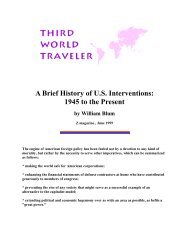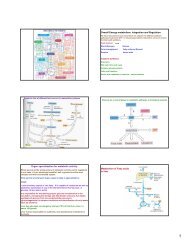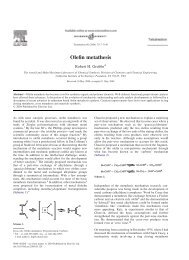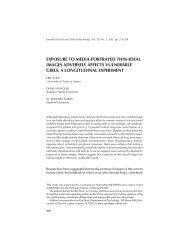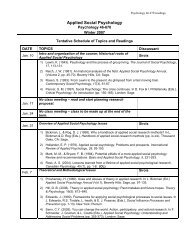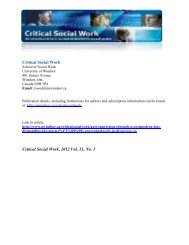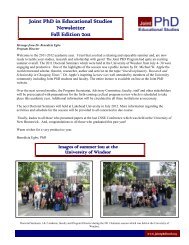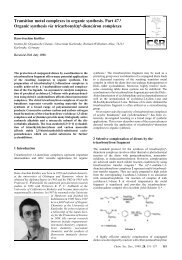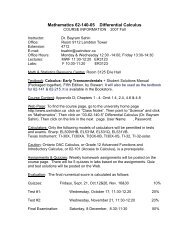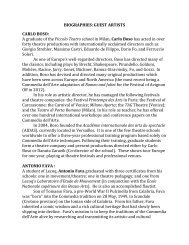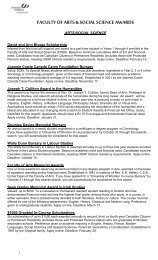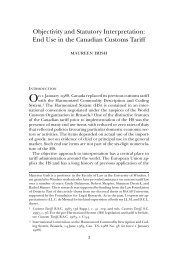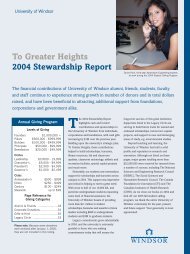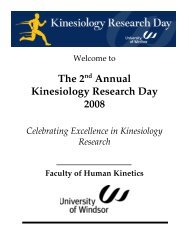ALLOWABLE REVIEWS TO STUDENT AND/OR SPOUSAL ASSET ...
ALLOWABLE REVIEWS TO STUDENT AND/OR SPOUSAL ASSET ...
ALLOWABLE REVIEWS TO STUDENT AND/OR SPOUSAL ASSET ...
You also want an ePaper? Increase the reach of your titles
YUMPU automatically turns print PDFs into web optimized ePapers that Google loves.
<strong>ALLOWABLE</strong> <strong>REVIEWS</strong> <strong>TO</strong> <strong>STUDENT</strong> <strong>AND</strong>/<strong>OR</strong> <strong>SPOUSAL</strong> <strong>ASSET</strong> CONTRIBUTION<br />
An adjustment to the assets as listed by the student and spouse on the OSAP application can be<br />
considered in a number of situations.<br />
Reviews to Increase the Exemption Level on Vehicles<br />
Students and their partners are required to report the current gross market value of vehicles that<br />
they own or lease as of the asset valuation date (i.e. 16 weeks prior to the start of their prestudy<br />
period).<br />
When calculating financial need, OSAP automatically applies an exemption of $5000 against the<br />
total combined value of all vehicles owned or leased by the student and partner. In the following<br />
situations, the exemption level may be increased to $10,000.<br />
� Public transit is not available for the student to use from his or her home to the<br />
postsecondary institution:<br />
Supporting Documentation Required:<br />
• Letter from the student indicating his or her transportation requirements and the<br />
reason for these arrangements (e.g. student lives beyond established routes for public<br />
transit system).<br />
� Public transit is more than one-hour’s travel from the student’s home to the<br />
postsecondary institution:<br />
Supporting Documentation Required:<br />
• Letter from the student indicating his or her transportation.<br />
� Public transit is not available for the employed partner of a married student to<br />
use from his or her home to place of employment:<br />
Supporting Documentation Required:<br />
• Letter from the student outlining the partner’s transportation requirements and<br />
confirmation of the location of the spouse’s place of employment.<br />
� Public transit is more than one-hour’s travel from the employed spouse of a<br />
married student’s home to their place of employment:<br />
Supporting Documentation Required:<br />
• Letter from the student indicating his or her spouse’s transportation requirements;<br />
• Confirmation of the location of the spouse’s place of employment.<br />
� Partner’s Employment Requires Access to a Vehicle:<br />
Supporting Documentation Required:<br />
• Letter from the partner’s employer indicating the requirement of a vehicle for<br />
employment purposes.<br />
1
� Access to a vehicle is required to fulfill the requirements of the student’s<br />
program of studies (e.g. work placements) and no public transit is available<br />
between the student’s home and work placements or the use of public transit<br />
involves more than one hour of travel from the student’s home to the work<br />
placement(s), or the work placement(s) must be more than 40 kilometers from<br />
the student’s home:<br />
Supporting Documentation Required:<br />
• Letter from the student outlining his or her transportation requirements and the<br />
reason for these arrangements.<br />
� A single student resides with parents and requires access to a vehicle in order<br />
to commute to the institution. To qualify for an increased vehicle exemption in<br />
this situation, the family home must be more than 40 kilometers or one hour<br />
travel time by public transit or be located where no public transit is available to<br />
the institution.<br />
Supporting Documentation Required:<br />
• Letter from the student indicating his or her transportation requirements and the<br />
reason for these arrangements.<br />
� A vehicle is required by a sole-support parent or married student to transport<br />
his/her dependent children (e.g. under the age of 12) to and from a child care<br />
provider.<br />
Supporting Documentation Required:<br />
• Letter from the student outlining his or her transportation requirements and<br />
confirmation of child care arrangement including location.<br />
� The vehicle is owned or leased by a student with disabilities or the disabled<br />
partner of a married student.<br />
Supporting Documentation Required:<br />
• Confirmation of the student’s or partner’s permanent disability consistent with OSAP’s<br />
definition of permanent disability. Note: If the vehicle is specifically equipped to<br />
accommodate the student’s disability, the entire value of the vehicle is exempt,<br />
regardless of its current gross market value.<br />
Adjustments to the Vehicle’s Gross Market Value<br />
� Adjustment to the current gross market value of one or more vehicles.<br />
A student can request that the original gross market value of the vehicle (and/or the vehicle<br />
of his or her partner) be adjusted if he/she believes that the original amount listed is an<br />
over-evaluation or if the Ministry has been unable to verify the vehicle’s value and has sent<br />
the student a letter (Notice of Vehicle Verification) to indicate that the student must<br />
document the value of a specific vehicle.<br />
Supporting Documentation Required:<br />
• A written, signed and dated independent vehicle appraisal. The appraisal must be<br />
dated on or after the asset valuation date i.e., 16 weeks prior to the start of the<br />
student’s study period. This document must identify the car in question (e.g. year,<br />
make, license plate number);<br />
2
• A letter of explanation from the student which identifies the vehicle (year, make,<br />
license plate number) for which a revised value is being provided.<br />
� The vehicle has been modified to accommodate a disability.<br />
If a student or spouse owns a vehicle which has been modified to accommodate a disability,<br />
i.e. Electronic ramp, then the market value of the vehicle is not considered when calculating<br />
an asset contribution.<br />
Supporting Documentation Required:<br />
• The student or the partner must self-identify as being permanently disabled;<br />
• A medical certificate;<br />
• A letter outlining the nature of the modification made to the vehicle.<br />
� The vehicle has been listed twice due to a license plate error.<br />
The license plate information is a factor in matching information from M<strong>TO</strong>. If the student<br />
did not report the license plate information accurately, then the results from M<strong>TO</strong> would<br />
yield a vehicle listed by the student and the same vehicle (under a different plate number)<br />
listed by M<strong>TO</strong>.<br />
Supporting Documentation Required:<br />
• A letter of explanation from the student. The letter must include details with respect<br />
to make and model, year and current market value of the vehicle;<br />
• A copy of the vehicle registration.<br />
Adjustment to the Vehicle’s Ownership<br />
Students are required to list any vehicles for which the ownership is in his or her name or that of<br />
his or her partner as of the asset valuation date. This includes vehicles that the student or partner<br />
has leased through a leasing company. A student can appeal to have the vehicle removed from<br />
their OSAP assessment under the following conditions:<br />
� The vehicle was sold after the asset valuation date.<br />
If a student and/or spouse sells the vehicle prior to the review deadline (i.e., eight weeks<br />
before the end of his/her study period), the value of the vehicle can be deleted for financial<br />
need assessment purposes, provided that the vehicle was sold for a reasonable market<br />
price and the proceeds of the sale are reflected on the application as other assets. The<br />
student must demonstrate that the change in ownership resulted from an “arm’s length<br />
market transaction”. Ownership transfers to family members will not be<br />
considered. (For OSAP purposes, family members are defined as parents,<br />
children, siblings, grandparents, aunts, uncles, in-laws, and cousins.)<br />
Supporting Documentation Required:<br />
• A letter from the student explaining when the vehicle was sold, including whether or<br />
not this transaction involved an immediate family member. The student must confirm<br />
that they have consulted with the Ministry of Transportation (M<strong>TO</strong>) and that they<br />
have had the records at M<strong>TO</strong> updated.<br />
• Documentation to confirm any debts repaid from proceeds of the sale of the vehicle.<br />
Debt must be directly related to financing the initial purchase of the same vehicle.<br />
� Termination of vehicle lease after the asset valuation date.<br />
3
If a student and/or spouse terminate the lease of a vehicle after the asset valuation date<br />
and prior to the review deadline (i.e., eight weeks before the end of his/her study period),<br />
the value of the vehicle can be deleted for need assessment purposes. Where the lease<br />
termination results in a net increase in the student/spouse’s financial assets, the new value<br />
of financial assets must also be reported for assessment purposes. The student must<br />
demonstrate that the change in ownership resulted from an “arm’s length market<br />
transaction”. For example, if the vehicle was being leased from family members, and the<br />
lease is terminated by the family members, the value of the vehicle will not be deleted. (For<br />
OSAP purposes, family members are defined as parents, children, siblings, grandparents,<br />
aunts, uncles, in-laws and cousins.)<br />
Supporting Documentation Required:<br />
• A letter from the student explaining when the lease was terminated, including<br />
whether or not this transaction involved an immediate family member. Student must<br />
confirm that they have consulted with M<strong>TO</strong> and have had the records at M<strong>TO</strong><br />
updated.<br />
• Documentation from the vehicle leasing company confirming the net cost of the lease<br />
termination.<br />
Reviews to Adjust Contribution From RRSPs<br />
Appeals related to expected contributions from RRSPs are not normally considered. However, if<br />
RRSPs have been listed in error or if the value has not been correctly stated, the file may be<br />
reassessed upon receipt of written clarification from the student and supporting documentation.<br />
The student must list the full net worth of all RRSPs registered to the student (and partner, if<br />
applicable) as of the asset valuation date.<br />
RRSPs are not to include the value of investments that are mandatorily locked in according to<br />
Section 60 (J) of the Income Tax Act. (“Locked in” does not refer to the student’s [or partner’s]<br />
choice to invest the funds for a specific time period.)<br />
Reviews to Adjust Contribution From Other Assets<br />
There is no review to the expected contribution from other assets, except for students with<br />
permanent disabilities and recipients of pain and suffering awards (see below). However, a<br />
student may provide clarification to the Financial Aid Office of the asset amount listed on the<br />
application.<br />
Students must report ‘the total gross value of all account balances at financial institutions, bonds,<br />
term deposits, GIC’s, all other investments, and any other assets not otherwise indicated already<br />
on the application which can be directed toward educational costs for the current study period.<br />
The items which should not be included are the value of a principal residence, clothing, furniture,<br />
personal belongings, non-economic loss and/or pain and suffering awards of less than $100,000,<br />
or OSAP funding.’<br />
OSAP funds from the previous study period are not to be included in the value of financial assets<br />
available. For example, students who are in receipt of OSAP during the four months prior to the<br />
start of the current study period can request an adjustment if they have included OSAP funds<br />
relating to this study period.<br />
Students must report all assets, world-wide (and the world-wide assets of their spouse) as of the<br />
date 16 weeks BEF<strong>OR</strong>E the start of their study period. If they start in September, then they<br />
would report their assets as of May. In order to verify assets, the Ministry may contact any<br />
4
persons or bodies, including government bodies within and outside of Canada, that may have<br />
information about their assets.<br />
Reviews to Adjust the Value of Pain and Suffering Award Reported as Other Assets<br />
Pain and suffering awards, including WSIB Non-economic loss (NEL) awards, in amounts less than<br />
$100,000 are exempt from assets. Any amount over $100,000 is considered an asset. If<br />
payments are made for different incidents, the payments related to each incident are exempt up<br />
to $100,000.<br />
Supporting Documentation Required:<br />
• a copy of a letter from WSIB, legal court document, or payment stubs specifying a pain<br />
and suffering or NEL award.<br />
Reviews to Adjust the Value of Other Assets for Students With Disabilities<br />
An adjustment to the expected contribution from Other Assets (i.e., Item 670) can be considered<br />
if:<br />
• The applicant has self-identified as a student with a permanent disability;<br />
• A student has a dependent child with a permanent disability;<br />
• A student’s spouse has a permanent disability.<br />
The expected contribution from Other Assets of the student may be adjusted as follows:<br />
• A single student is expected to contribute 100% of Other Assets in excess of $3,000.<br />
• A sole-support parent is expected to contribute 100% of Other Assets in excess of $5,000.<br />
This exemption level is increased by $500 for each dependent child.<br />
• A married student is expected to contribute 100% of Other Assets in excess of $5,500. This<br />
exemption level is increased by $500 for every dependent child.<br />
Supporting Documentation Required:<br />
• A letter from the student requesting a review of their assets based on the fact that they<br />
have documented a permanent disability.<br />
Funding from an In-Trust Account<br />
An in-trust account is an “informal trust” set up with a financial institution to invest funds for a<br />
minor (the “beneficiary”). A donor contributes to the plan for the beneficiary. The trustee (who<br />
can be different from the donor) manages the investments in the account and acts on behalf of<br />
the beneficiary until the beneficiary reaches age of majority. The assets belong to beneficially the<br />
child and must generally be held for the child until the age of majority.<br />
As outlined below, money held in or withdrawn from a student’s In-Trust Account may or may not<br />
be considered an asset or income when assessing financial need.<br />
In-Trust Accounts as Income<br />
Withdrawals from an In-Trust Account in the current study period that are made by the student<br />
or by the account’s trustee and transferred to the student must be reported as either pre-study or<br />
study period income on the OSAP application, depending on when the amount was withdrawn.<br />
In-Trust Accounts as Assets<br />
An In-Trust Account is considered an asset only if the student has access to the funds during the<br />
current study period but has chosen not to withdraw the money to help fund their postsecondary<br />
studies.<br />
5
The value of the asset must reflect the amount of funding available to the student in the current<br />
year that has not been withdrawn. For example, if a Trust is valued at $5000 but as per the<br />
conditions of the account the student can only access $1000 per year, then only $1000 can be<br />
considered as an asset. As described above, any amount the student withdraws is considered<br />
income.<br />
In-Trust Accounts that are Exempt from the Need Assessment<br />
If ANY of the following is true, then an In-Trust Account is exempt from the student’s need<br />
assessment.<br />
• The trustee of the account or the student cannot access the account for any reason until the<br />
student reaches a specified age (i.e., student/trustee cannot withdraw funds during the<br />
current study period); or<br />
• The student will not come of age during the current study period, and the trustee has<br />
refused to exercise discretion to remove from the account for the student’s use; or<br />
• The conditions attached to the account explicitly state that the funds are not to be used for<br />
postsecondary studies.<br />
Documentation Required:<br />
• A copy of the documentation used to determine the conditions under which the student<br />
and/or the trustee have access to the funds;<br />
• A letter signed and dated by the student indicating that he/she contacted the trustee to<br />
disburse the funding; and<br />
• A letter signed and dated by the trustee indicating refusal to disburse any funds to the<br />
student during his/her current study period, if applicable, or indicating the total amount<br />
that was or will be disbursed during the current study period.<br />
6
Appeal Submission Cover Sheet –<br />
Asset Contribution Appeal<br />
Please forward to:<br />
Student Awards & Financial Aid Office<br />
401 Sunset Ave.<br />
Windsor, ON N9B 3P4<br />
LAST NAME:<br />
FIRST NAME:<br />
U OF W <strong>STUDENT</strong> ID:<br />
SOCIAL INSURANCE #:<br />
DATE OF BIRTH:<br />
APPEAL SUBMISSION<br />
CHECKLIST:<br />
Financial Aid Office Notes:<br />
o A letter from you outlining your request for appealing your OSAP<br />
assessment and under what grounds you are appealing;<br />
o Supporting documentation to support your request for appeal.<br />
o Be sure that your letter(s) are SIGNED, DATED and that your name<br />
and student ID# appears on all of your supporting documentation.<br />
The University of Windsor is committed to the protection of privacy and confidentiality of all its constituents. The information collected in this process is collected<br />
under the authority of the University of Windsor Act, 1962 and is collected for the purposes of administering the Ontario Student Assistance Program (OSAP) on<br />
behalf of the Ministry of Training, Colleges & Universities and any other need-based financial assistance as administered by the University of Windsor. If you have<br />
any questions about the collection of information or the uses to which it will be put, please direct your questions to the Director, Student Awards & Financial Aid.<br />
The ministry administers OSAP under the authority of the Ministry of Training, Colleges and Universities Act, R.S.O. 1990, c. M.19, as amended, R.R.O. 1990, Reg.<br />
773, Reg. 774, and Reg. 775, as amended, and O. Reg. 268/01, as amended; the Financial Administration Act, R.S.O. 1990, c. F. 12, as amended; the Canada<br />
Student Financial Assistance Act, S.C. 1994, c. 28, as amended; the Canada Student Financial Assistance Regulations, S<strong>OR</strong> 95-329, as amended; and the Budget<br />
Implementation Act, 1998, S.C. 1998, c. 21, as amended. If you have any questions about the collection or use of this information, contact the Director, Student<br />
Support Branch, Ministry of Training, Colleges and Universities, PO Box 4500, 189 Red River Road, 4th Floor, Thunder Bay, ON P7B 6G9.<br />
Updated April 2008/jm<br />
Office Use:<br />
Date Received: __________________<br />
Date Reviewed: __________________<br />
□ Approved □ Not Approved<br />
7



